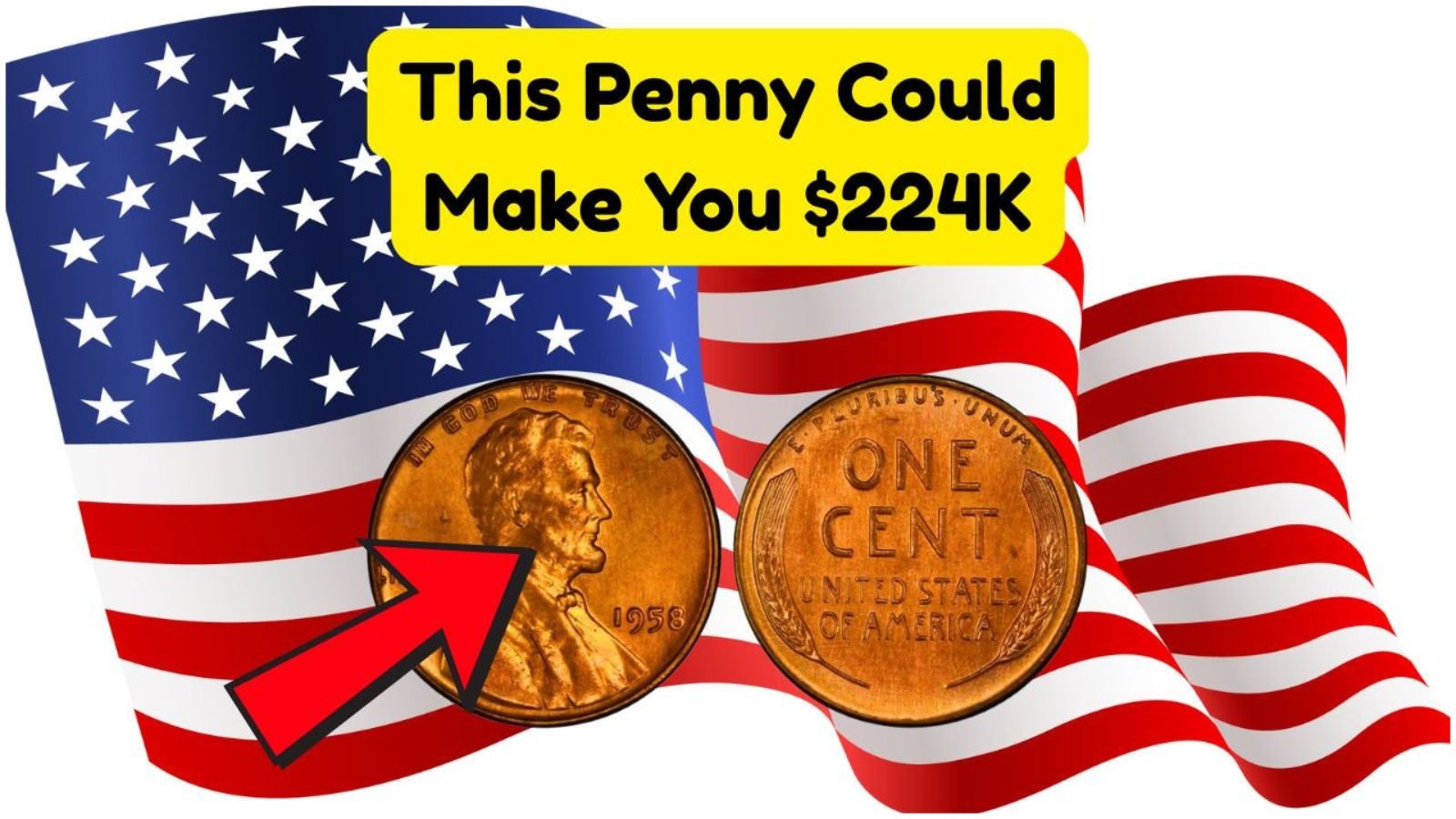The Rare Lincoln Wheat Penny stands as one of the most iconic and intriguing coins in American numismatic history. At first glance, it might appear as just another penny lost in your pocket change. However, for those with a sharp eye and a little historical knowledge, the Lincoln Wheat Penny can be a gateway to both a rich past and a surprisingly valuable investment. First minted in 1909 to celebrate the 100th anniversary of Abraham Lincoln’s birth, these pennies were in circulation until 1958. While most examples are common and worth little more than face value, rare variants and mint errors have elevated some Lincoln Wheat Pennies to the status of coveted collectibles—occasionally commanding auction prices over $200,000.
The History Behind the Lincoln Wheat Penny
The Lincoln Wheat Penny, designed by renowned sculptor Victor D. Brenner, was a groundbreaking coin. It was the first U.S. coin to feature a real person, breaking from the tradition of using symbolic figures. The obverse depicted a profile of President Abraham Lincoln, while the reverse featured two wheat stalks flanking the words “ONE CENT,” giving the coin its popular nickname.
The original 1909 coin also bore Brenner’s initials, “V.D.B.,” on the reverse, which led to controversy. Critics found the initials too prominent, and they were quickly removed, only to be subtly reinstated in 1918. This small detail makes the 1909-S V.D.B. Lincoln Wheat Penny one of the most desirable for collectors, as it represents both a design milestone and a rare first-year issue.
What Makes a Lincoln Wheat Penny Rare and Valuable?
To truly appreciate the Rare Lincoln Wheat Penny, it’s crucial to understand what factors influence its value. There are several considerations:
- Rarity: The fewer coins that were minted, the more valuable they typically are. For example, the 1914-D and 1931-S had notably low mintages.
- Mint Errors: Coins that were mistakenly struck using incorrect planchets or with doubled designs can be worth thousands. The 1943 copper penny and the 1955 doubled die are prime examples.
- Condition: Graded from Poor to Mint State (MS), a penny’s condition can drastically impact its value. Coins with high grades and original luster are prized.
- Mint Mark: The letter under the date (S for San Francisco, D for Denver, and no mark for Philadelphia) can affect the coin’s scarcity.
- Provenance: Coins with well-documented histories may command premium prices.
Some Lincoln Wheat Pennies are so rare they’ve become legendary in the numismatic community. The 1943 copper penny, for instance, is believed to exist in only about 40 examples. That year, pennies were supposed to be struck on steel planchets to save copper for the war effort. Yet, a few copper blanks remained in the mint and were accidentally used—creating a fantastically valuable rarity.
Charting the Most Valuable Rare Lincoln Wheat Pennies
| Year | Mint Mark | Error Type | Known Quantity | Estimated Value | Recent Auction Price | Notes |
|---|---|---|---|---|---|---|
| 1909 | VDB | None | Unknown | $50 – $200 | $150 | First Year of Issue |
| 1914 | D | None | Unknown | $200 – $1,500 | $1,000 | Low Mintage Year |
| 1922 | No D | Mint Error | Few | $500 – $20,000 | $15,000 | Missing Mint Mark |
| 1943 | P, D, S | Copper Planchet | 40 | $10,000 – $200,000 | $185,000 | Steel Penny Year |
| 1955 | P | Doubled Die | Few | $1,000 – $15,000 | $12,000 | Clear Doubling |
| 1944 | P, D, S | Steel Planchet | Unknown | $30,000 – $100,000 | $90,000 | Transition Year |
| 1958 | P | Doubled Die | Few | $50,000 – $250,000 | $224,000 | End of Wheat Penny |
| 1931 | S | None | Unknown | $100 – $300 | $250 | Low Mintage |
Identifying a Rare Lincoln Wheat Penny in Your Collection
Finding a Rare Lincoln Wheat Penny doesn’t necessarily require decades of experience. Even beginners can identify potentially valuable coins with some attention to detail. Here’s how:
- Examine the Date and Mint Mark: Start by checking the year and identifying the mint location. Some combinations, like 1914-D or 1922 No D, are far more valuable.
- Inspect for Errors: Use a magnifying glass to look for doubling in the letters or numbers. Also, unusual coloration or metal composition may indicate an error.
- Compare to Known Variants: Keep reference images of famous error coins handy. Use them to match what you see under the magnifier.
- Weigh the Coin: A scale that reads to 0.01 grams can help identify composition anomalies. For instance, a 1943 copper penny should weigh around 3.11 grams, unlike its steel counterpart.
- Seek Professional Help: A certified coin appraiser or third-party grading service can authenticate and grade your coin for market resale or insurance.
Tips for Collecting Lincoln Wheat Pennies
Collecting Rare Lincoln Wheat Pennies is more than just a pastime—it’s a deep dive into U.S. history and a potentially profitable investment. Here are some strategies for starting or improving your collection:
- Get a Comprehensive Coin Guide: Books like the “Red Book” (A Guide Book of United States Coins) provide essential details, pricing, and rarity indicators.
- Join Collector Clubs: Organizations like the American Numismatic Association (ANA) provide resources, access to exclusive shows, and expert guidance.
- Attend Coin Shows: These events offer face-to-face networking opportunities and the chance to inspect rare coins in person.
- Utilize Online Marketplaces: eBay, Heritage Auctions, and other platforms often feature rare listings. Be sure to only purchase from reputable sellers.
- Keep Your Eyes on Your Spare Change: Many collectors have found valuable coins in circulation. That 1944 steel penny or 1955 doubled die could be hiding in your coin jar.
The Changing Face of the Lincoln Wheat Penny
Throughout its nearly 50-year run, the Lincoln Wheat Penny went through several notable changes—each reflective of its era:
| Year | Material | Designer | Reverse Design |
|---|---|---|---|
| 1909 | Copper | V.D. Brenner | Wheat Ears |
| 1918 | Copper | V.D. Brenner | Wheat Ears with V.D.B. |
| 1943 | Steel | V.D. Brenner | Wheat Ears |
| 1944 | Copper | V.D. Brenner | Wheat Ears |
| 1958 | Copper | V.D. Brenner | Wheat Ears |
| 1959 | Copper | F. Gasparro | Lincoln Memorial |
| 1982 | Zinc | F. Gasparro | Lincoln Memorial |
| 2009 | Zinc | Various | Four Bicentennial Designs |
Each design shift and material change contributes to the historical narrative behind the coin. The 1943 switch to steel and back to copper in 1944 is especially fascinating, symbolizing the nation’s resourcefulness during World War II.
Proper Preservation of Your Lincoln Wheat Pennies
Preserving the condition of a Rare Lincoln Wheat Penny is essential for long-term value. Here’s how:
- Store in a Cool, Dry Place: Avoid moisture and humidity, which can lead to corrosion.
- Use Acid-Free Holders or Coin Flips: These prevent chemical reactions with the metal.
- Avoid Cleaning the Coins: Even light cleaning can strip natural patina and lower market value.
- Professional Conservation: For coins of high value, consider expert conservation services.
- Maintain Records: Document each coin’s condition, purchase date, and provenance. This can significantly increase resale value.
Understanding the Rare Lincoln Wheat Penny Market
The market for the Rare Lincoln Wheat Penny is a living ecosystem influenced by trends, demand, and new discoveries. Auction houses like Stack’s Bowers and Heritage often set benchmark prices. Subtle changes in collector demand can send prices soaring. A coin that was worth $1,000 a decade ago might now fetch ten times that, especially if it is a high-grade or error coin.
If you’re collecting as an investment, diversification is wise. While focusing on rare Lincoln Wheat Pennies is a great strategy, also consider expanding into other denominations or world coins. This broader approach can hedge against market fluctuations and provide new collecting opportunities.
Building a Legacy with Rare Lincoln Wheat Pennies
Many collectors view their Lincoln Wheat Penny collections as family legacies. A well-curated album passed down through generations carries both emotional and monetary value. Some collectors even donate exceptional coins to museums or numismatic institutions, securing their place in American history.
Sharing your passion with others—whether through blogs, social media, or community forums—not only keeps the hobby alive but also builds a lasting legacy for future numismatists.
Final Thoughts: More Than Just a Penny
The Rare Lincoln Wheat Penny is more than a forgotten coin in your change—it’s a tangible piece of American history and a testament to the intricacies of minting and design. Whether you’re a casual enthusiast or a serious investor, the journey of collecting these coins offers endless rewards. By educating yourself, preserving your collection, and engaging with the broader community, you can transform a humble one-cent coin into a treasure trove of historical and financial significance.
Some Important Link
| Telegram Group | Click Here |
| WhatsApp Group | Click Here |
| Home Page | Click Here |










